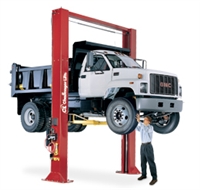Vehicle Lift Safety Guide
Vehicle lifts are an extremely important piece of equipment for any auto shop, as they enable you to raise vehicles to a suitable level and give you access to whatever you need to make repairs and fixes. From swapping out old parts to building entirely new systems, a high-quality lift will become your best companion and is an irreplaceable part of any shop. However, they can also be a dangerous piece of equipment. Our vehicle lift safety guide makes sure you are well prepared to use this remarkable piece of technology every day with the safety and security you deserve. Proper preparation can help minimize risks to your shop, your vehicles, and above all else, yourself!

There are many hazards to consider when using your lift. Ensure every mechanic at your shop is well trained for any situation with these quick tips:
- Vehicle lift safety begins with training. Read through and understand the manual of your specific lift. This will ensure you are familiar with the safety features, maintenance guidelines, and operation of your equipment.
- Perform regular inspections on your lift, and make sure you have an annual checkup from a qualified lift technician. Follow manufacturer guidelines to keep your lift at its best.
Check the cables and chains on your lift on a daily basis for wear and tear. Also, make sure the safety latches are functioning properly.
- Once a month, check and tighten all anchors and fasteners to the specifications listed in your manual. Also, check that your lift is equalized properly, and replace hydraulic fluid if necessary. Finally, check hoses for cracks or other signs of wear.
- Ensure any vehicle you plan to lift does not exceed the maximum weight capacity of your equipment. This includes looking inside the vehicle for any unexpected heavy loads that can push the vehicle above the limit of your lift.
- Clean the area to avoid any unnecessary accidents. Clean up any oil spills, stray tools, or other debris that could get in your way while you work.
- Have a spotter guide you and your vehicle into the lifting area. Spotters should stand to the side of the path to ensure they are not hit in the event of an accident.
- Line up the vehicle with the recommended lift points as stated by the manufacturer or the Automotive Lift Institute.
- Place wheel blocks in front of and behind at least one wheel to prevent slipping. Once you begin lifting, stop and check the lifting points when they connect with the vehicle to be sure they are correctly aligned.
- Raise the vehicle a foot in the air and recheck the lifting points for alignment. If they are aligned, shake the rear of the vehicle to be sure the vehicle does not move. Never look away from the vehicle while it is in motion.
- Place safety latches once your lift is at the desired height before you begin work, always raise the jack stands to the height of the vehicle, never lower the vehicle to match them.
- When lowering a vehicle, remove any stands, jacks, tools, caddies, or any other items or debris. Never walk under a vehicle with the safety latches disengaged, walk around the outside of the vehicle.
- Never lift a vehicle with a passenger inside.
- Never allow customers into the lifting bay.
- Do not attempt to support a falling vehicle.
- Do not try to use a damaged lift, or rig controls or latches, you cannot improvise on lift hardware or accessories.
- Do not attempt to repair a lift yourself, call an expert to ensure the job is done properly so you can guarantee your lift is safe.
By following the guidelines in this vehicle lift safety checklist, you can use your vehicle lift every day without worry. These are remarkable pieces of equipment that can make auto repair work much easier and more efficient, but they can also be very dangerous if used improperly. Take proper precautions to be informed and use your equipment as it was intended to be used, and you can get jobs done quicker and easier without worry or risk.
Related Topics











 Owned & Operated in the U.S. since 1987
Owned & Operated in the U.S. since 1987




